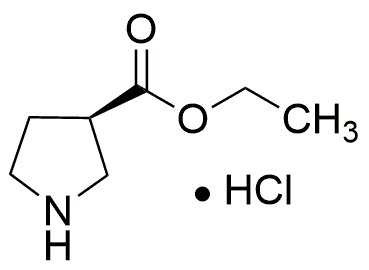Ethyl (R)-pyrrolidine-3-carboxylate hydrochloride is widely utilized in research focused on:
- Synthesis of Pharmaceuticals: This compound serves as an important intermediate in the synthesis of various pharmaceuticals, particularly in the development of drugs targeting neurological disorders.
- Chiral Building Block: As a chiral molecule, it is used in asymmetric synthesis, allowing researchers to create compounds with specific stereochemistry, which is crucial in drug development.
- Research in Organic Chemistry: It is often employed in organic chemistry laboratories for the study of reaction mechanisms and the development of new synthetic pathways.
- Biochemical Studies: The compound is utilized in biochemical research to explore enzyme interactions and metabolic pathways, providing insights into cellular functions.
- Material Science: Its properties make it suitable for applications in material science, particularly in the development of polymers and other advanced materials.
General Information
Properties
Safety and Regulations
Applications
Ethyl (R)-pyrrolidine-3-carboxylate hydrochloride is widely utilized in research focused on:
- Synthesis of Pharmaceuticals: This compound serves as an important intermediate in the synthesis of various pharmaceuticals, particularly in the development of drugs targeting neurological disorders.
- Chiral Building Block: As a chiral molecule, it is used in asymmetric synthesis, allowing researchers to create compounds with specific stereochemistry, which is crucial in drug development.
- Research in Organic Chemistry: It is often employed in organic chemistry laboratories for the study of reaction mechanisms and the development of new synthetic pathways.
- Biochemical Studies: The compound is utilized in biochemical research to explore enzyme interactions and metabolic pathways, providing insights into cellular functions.
- Material Science: Its properties make it suitable for applications in material science, particularly in the development of polymers and other advanced materials.
Documents
Safety Data Sheets (SDS)
The SDS provides comprehensive safety information on handling, storage, and disposal of the product.
Product Specification (PS)
The PS provides a comprehensive breakdown of the product’s properties, including chemical composition, physical state, purity, and storage requirements. It also details acceptable quality ranges and the product's intended applications.
Certificates of Analysis (COA)
Search for Certificates of Analysis (COA) by entering the products Lot Number. Lot and Batch Numbers can be found on a product’s label following the words ‘Lot’ or ‘Batch’.
*Catalog Number
*Lot Number
Certificates Of Origin (COO)
This COO confirms the country where the product was manufactured, and also details the materials and components used in it and whether it is derived from natural, synthetic, or other specific sources. This certificate may be required for customs, trade, and regulatory compliance.
*Catalog Number
*Lot Number
Safety Data Sheets (SDS)
The SDS provides comprehensive safety information on handling, storage, and disposal of the product.
DownloadProduct Specification (PS)
The PS provides a comprehensive breakdown of the product’s properties, including chemical composition, physical state, purity, and storage requirements. It also details acceptable quality ranges and the product's intended applications.
DownloadCertificates of Analysis (COA)
Search for Certificates of Analysis (COA) by entering the products Lot Number. Lot and Batch Numbers can be found on a product’s label following the words ‘Lot’ or ‘Batch’.
*Catalog Number
*Lot Number
Certificates Of Origin (COO)
This COO confirms the country where the product was manufactured, and also details the materials and components used in it and whether it is derived from natural, synthetic, or other specific sources. This certificate may be required for customs, trade, and regulatory compliance.


